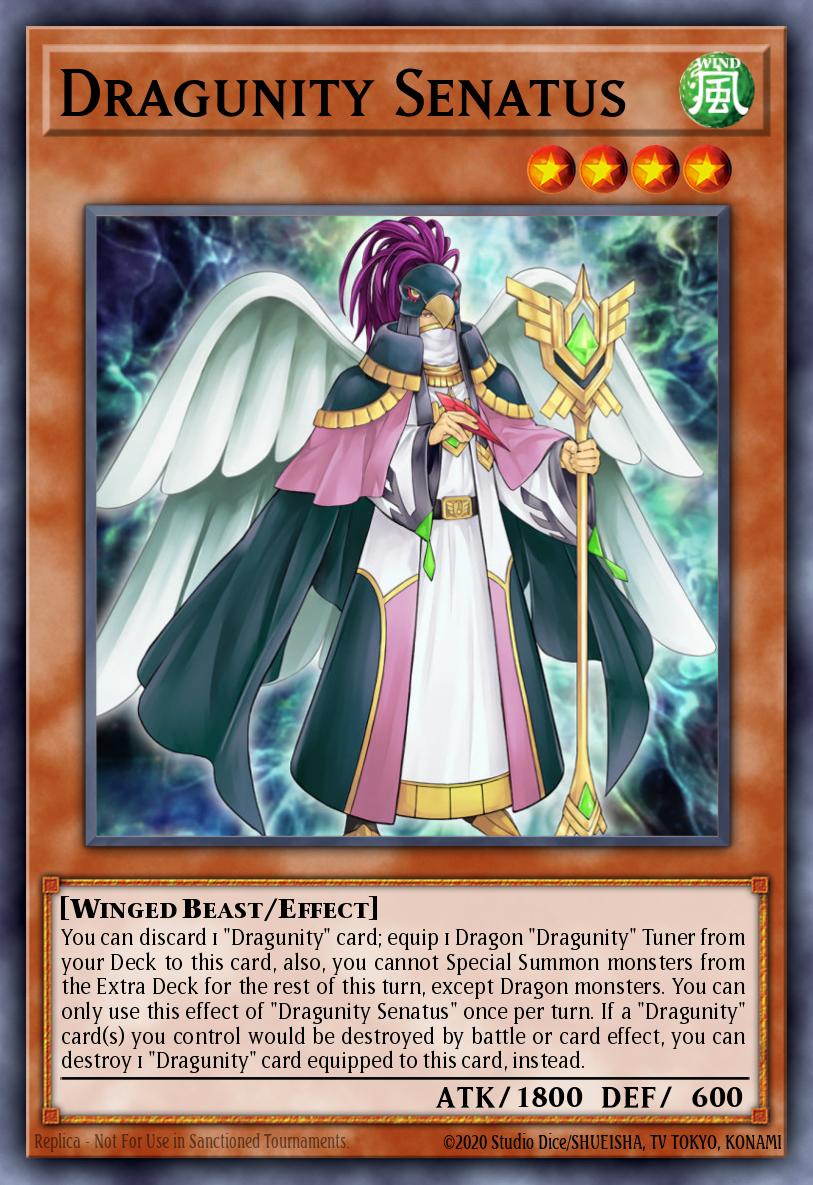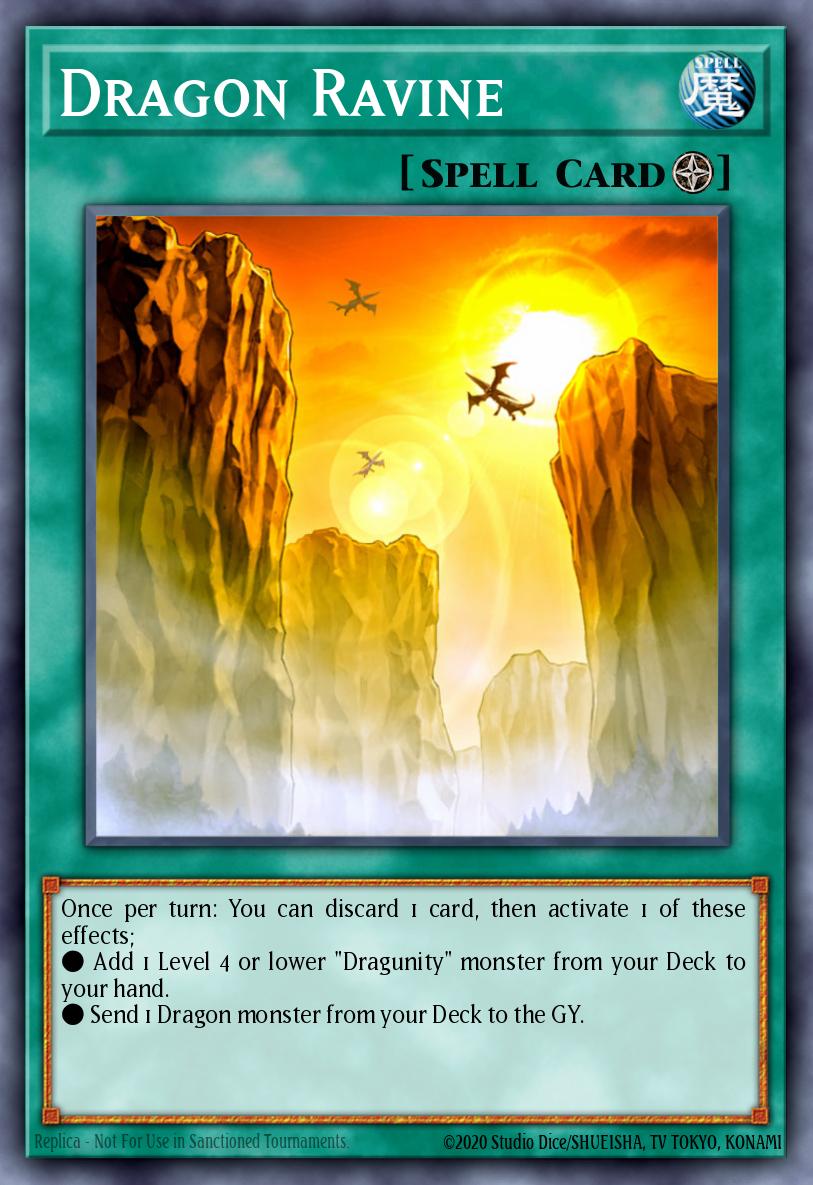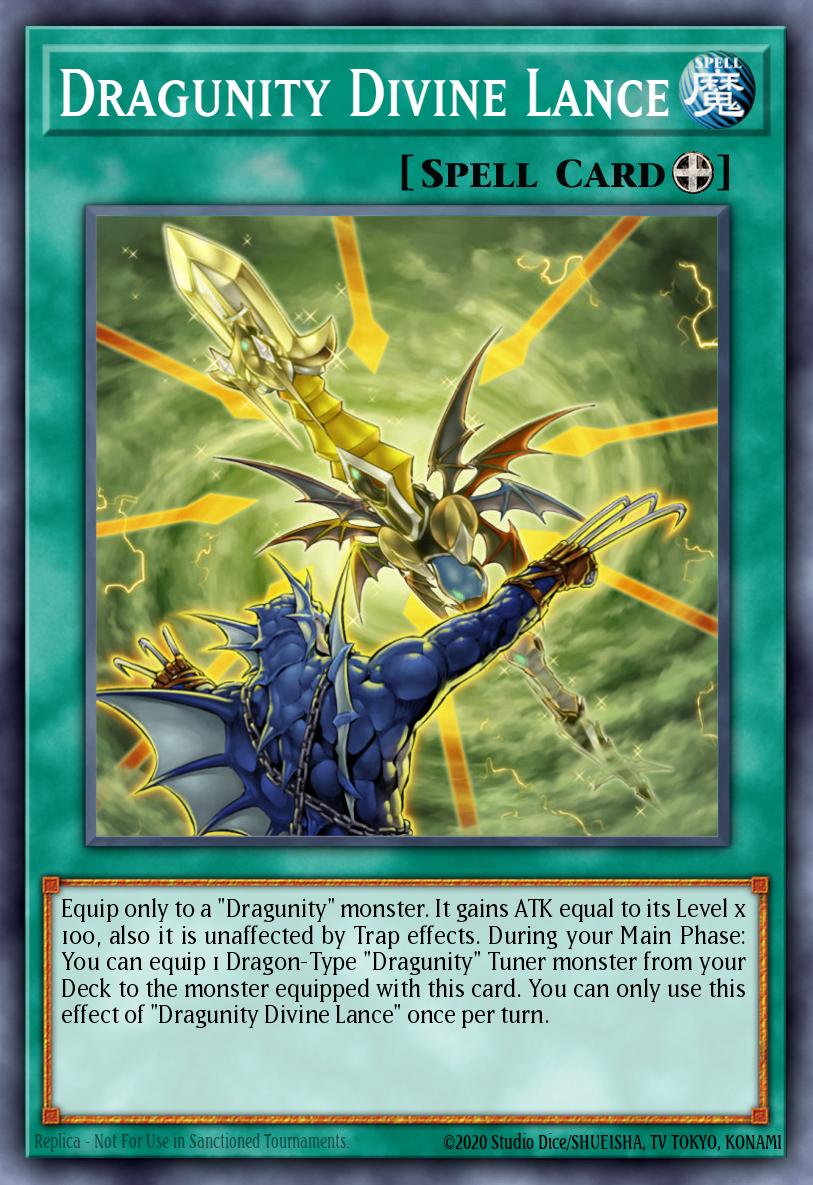Prologue
Dragunity made its debut in 2011, found in the Duel Terminal and consisting of Winged Beasts and Dragon "Union" Monsters. They also got a Structure Deck in the same year and received further support in Hidden Arsenal 4.
The Dragunity Archetype specializes in Synchro Summoning. Their greatest strength consists of summoning powerful Dragon Synchros to take control of the board and push for lethal damage. Throughout the years, the Dragunity archetype has featured multiple strategies ranging from "Assault Mode Turbo" to the "Levyaten LADD Loop". In modern day Yugioh, Dragunity is often played as a combo deck that swarms the board with powerful and disruptive monsters. As Dragons pack some of the most threatening monsters in the game, Dragunity can take full advantage and play all the strong Extra Deck Dragons.
With the announcement of the Structure Deck Revival : Draguity Drive, let's look into some of Dragunity's most impactful cards and non-archetype specific support.
Archetype Support
Main Deck Monsters
Dragunity Phalanx

Dragunity Phalanx is one of the 1st Dragunity cards and is a key player in many of the archetype's combos.
Phalanx's effect allows it to be special summoned from the S&T zone while being equipped to a monster. As a non-hard OPT, multiple Phalanxs can be summoned, provided they find themselves equipped to a monster. This makes Phalanx combo with other Dragunity monsters to quickly climb into a Level 6 and 8 Synchro or a Link-2 monster. Phalanx also acts as an enabler for Guardragons, which can help extend your combos.
Overall, Phalanx is a staple card in the archetype that will often be ran at 3. Although it's not the only playable tuner, it is the only playable one with no restrictions. Decks should focus on quickly getting Phalanx to the GY with cards like Foolish Burial and Dragon Ravine.
Dragunity Couse
Dragunity Couse is one of the newer Dragunity cards and has a similar effect to Phalanx.
Couse is able to act as a Level 4 when used for a Synchro Summon. This effect comes with the drawback of only being usable as a Synchro Material for a Dragunity Synchro. This makes Couse great for Level 8 Dragunity Synchros, such as Dragunity Knight - Barcha. Couse is also a great Link material where its restriction doesn't apply.
Although Couse isn't as flexible as Phalanx, it gives options where Phalanx does not. An example is allowing you to Synchro straight to 8, skipping the Level 6 Dragunity Knight - Vajrayana in the middle. Couse should be your 2nd priority when stacking the GY and even 1st in certain situations.
Dragunity Senatus

Dragunity Senatus is another newer Dragunity card and can be one of the best Normal Summons in the archetype.
Senatus's primary effect serves as a pseudo-Foolish Burial while also equipping a Dragon Dragunity tuner from your deck to itself. This makes Senatus great in conjunction with discarding Couse or Phalanx as it can quickly stack your GY. Senatus also comes with a restriction of only being able to summon Dragon monsters from the Extra Deck the turn you use this effect. However, this restriction is often irrelevant as most Dragunity decks will only be playing Dragons in the Extra Deck anyways.
Overall, Senatus is great as it offers a 1.5 card setup and acts as a solid opener. When going for your 1st turn play, it's usually preferable to see Senatus in combination with a Phalanx or Couse in your hand.
Dragunity Dux

Dragunity Dux is an older Dragunity card and is often your 2nd best normal summon in the archetype.
Dux is your standard Dragunity monster that equips 1 level 3 or lower Dragon Dragunity from your GY to itself upon normal summon. Alongside working with Phalanx and Couse, Dux is also usually a 1900+ ATKer that can help rid the field of problematic cards like Inspector Boarder. Dux acts as an opener similar to Senatus. Unlike Senatus, Dux doesn't have any cost at the price of not offering any setup. This makes Dux great for when you already have a stacked GY, but worse if you open it with no prior setup.
Dux is usually the monster you want to summon after you're already setup. By offering easy recovery and pushing power, Dux is a great option in the grind game. Dux also allows more variety in your extra deck outside of Dragons such as Cryston Halqifabrax and Simorgh, Bird of Sovereignty.
Dragunity Arma Mysteltainn

Dragunity Arma Mysteltainn debuted in the original Dragunity Structure Deck and serves as one of the few archetype specific extenders.
Mysteltainn acts as an extender by special summoning itself from the hand by sending 1 Dragunity monster you control to the GY. Upon summon, Mysteltainn equips 1 Dragunity monster in your GY to itself. This effect primarily accumulates an extra monster on the field, allowing easier access to Link-3s. Mysteltainn also helps ensure that your combo doesn't stop if you were to get hit by a hand-trap such as Effect Veiler or Infinite Impermanence.
Overall, Mysteltainn is a solid 3 of as it's a non-hard OPT that extends your combo. Use it when building your board or pushing for game as it can easily go into strong Level 8 Synchros. Since the archetype doesn't have too many extenders, Mysteltainn is a great include in any Dragunity deck.
Spells & Traps
Dragon Ravine

Dragon Ravine is Dragunity's Field Spell and their bread and butter set-up, consistency, and extender card. Released in the Dragunity Legion Structure Deck, Dragunity was one of the 1st archetypes to get a field spell that was significant to their strategy and win conditions.
Dragon Ravine features 2 powerful effects that can be activated by discarding a card from your hand. Ravine's 1st effect adds one Level 4 or lower Dragunity from your Deck to hand. This effect gives you a way to discard monsters you want in the GY and add a Dragunity Dux or Senatus to hand. Players also have the option to add Phalanx or Couse if trying to set-up a Cards of Consonance or a Senatus they already have. This effect is particularly powerful when you discard a Zephyros or Tempest.
Ravine's 2nd effect allows you to send 1 Dragon monster from your Deck to GY. Since it doesn't specify Dragunity, it has more options and more combo potential. Popular options include Darkwurm and Tempest. Alternatively, Ravine also offers an easy way to send Phalanx or Couse from the deck to the GY.
Historically, Ravine is a card that adds consistency to many combos. As a searchable non hard-OPT field spell, Ravine serves as a combo piece in many Dragon decks. A common combo is using Zephyros to return Ravine to handand using it again. Additionally, Ravine is searchable by Dragunity Knight-Romulus which makes it relatively accessible.
Overall Ravine, although not as essential as it was in 2011, is still an amazing card for the archetype. Even though Ravine isn't as crazy as some of the modern day archetypal field spells, its easy access and value in the deck is still invaluable. Hopefully with Dragunity Drive we receive a retrain that will make Ravine comparable to modern day field spells. Until then, Ravine is still a solid auto-include in any Dragunity deck.
Dragunity Divine Lance

Dragunity Divine Lance is an equip spell released in SECE. As a searchable equip spell, Lance's main use in the deck is to offer a layer of protection while also being an extender.
Lance's main effect is to equip 1 Dragon-Type Dragunity Tuner from your deck to Lance's equip target. This effect, though simple, offers a lot to the archetype as it essentially tutors a monster from your deck. Although Phalanx and Couse will be the most often targets, Aklys can also be tech'd as a spot removal.
Lance also has a secondary effect that passively protects the equipped monster from the effects of Traps. Although not extremely relevant, this could help protect you from Infinite Impermanence if your opponent poorly times it.
Lance is great since it's an extender that's searchable with Dragunity Knight - Romulus. Offering set-up from deck, even having multiples copies isn't terrible. Lance is a very flexible card that often acts as an extender, but can offer much more. Using Lance to its fullest potential could turn the tides of games and catch unsuspecting opponents off guard.
Non-Archetype Support / Considerable Cards
Blackwing - Zephyros the Elite
Blackwing - Zephyros the Elite is an amazing combo card that can be searched and dumped through Dragunity Knight - Gae Dearg.
With this interaction, Zephyros acts as an easy to access extender that serves as link or synchro material. Zephyros is particularly good as it can also recycle cards that you have on the field that you may want to use again. Popular options include Dragon Ravine, Divine Lance, and even Mysteltainn. By using Zephyros to return these cards, you can get second and sometimes 3rd uses out of them turning a single Zephyros into multiple follow-up plays.
Tempest, Dragon Ruler of Storms
Tempest, Dragon Ruler of Storms is a WIND Dragon monster with an easy summoning condition.
Acting as an extender, Tempest helps accumulate damage on board and helps link climb during your combos. Tempest also has a searching effect which activates upon being banished. This effect is useful for helping you get to your Dragunity tuners as they are all WING Dragons. Tempest also works well with another tech option Koa'Ki Meiru Drago which is talked about more in-depth below.
Red-Eyes Darkness Metal Dragon
Red-Eyes Darkness Metal Dragon is one of the strongest Dragon extenders with high attack to boot.
REDMD is able to revive powerful monsters and provide huge damage by itself. It's also easily searchable by dumping it from deck and reviving it or simply using Guardragon Elpy's effect. Although it's slated for an errata soon, REDMD is easily one of the strongest Dragon support cards ever released and will be an auto-include.
Amorphage Sloth / Amorphage Goliath
Both Amorphage monsters provide lockdown effects and can be easily summoned using Guardragon Elpy. After building a board, an Amorphage Goliath can help lock down a win by restricting your opponent's Extra Deck access.
When deciding which one to play, Sloth is a more flexible monster as it only requires 1 tribute to Normal Summon if that ever comes up. Goliath on the other hand boasts more attack, but is harder to tribute summon. In Dragunity, Goliath is often the better choice as it can be easily discarded for Ravine or Gae Dearg. After being discarded, it can be brought back through Guardragon Pisty or REDMD.
Supreme King Dragon Darkwurm + Supreme King Gate Zero
The Supreme King engine enables a starting play without using your normal summon. Darkwurm assists into linking into Guardragons and Dragunity Knight - Romulus, while Gate Zero can be discarded for Dragon Ravine.
Darkwurm is a notable option as there are multiple ways to get Darkwurm to the GY. The most popular ways are discarding it off Ravine or with Dragon Shrine. Since your normal summon is so important, having a card to help bait negates without using it is often invaluable in this type of archetype.
Koa'ki Meiru Drago
Koa'ki Meiru Drago is a 1900 ATK WIND Dragon that disables the special summoning of LIGHT and DARK monsters. Drago can be searched through Tempest or summoned through a Guardragon and is great for locking down the board. Against LIGHT and DARK archetypes that are always popular, Drago is a great option and can single-handedly win games.
Use Drago as a side deck option or even in the Main Deck in a LIGHT and DARK heavy meta. In the worst case, Drago can serve as discard fodder for your many discard effects and can even be a beater in a pinch.
Dark Simorgh
Dark Simorgh is a 2700 ATK WIND/DARK Monster that is summoned from the hand by banishing 1 WIND and DARK Monster from the GY. It can also be summoned from the GY by banishing 1 DARK and WIND Monster from the hand.
Simorgh is a very niche monster that prevents your opponent from setting cards. This makes Simorgh a great option against backrow heavy decks and even works against setting effects like Trap Trick and Shaddoll Falco. Since the deck runs DARK monsters in the form of Darkwurm, Gate Zero, and Zephyros, they can serve as banish fodder after their initial use. The GY summoning effect also comes up in situations where Simorgh is dumped to the GY and then summoned by banishing a potential Gate Zero + WIND monster from the hand.
Simorgh is a great side deck option that can be mained in metas where setting cards is more popular.
Conclusion
Dragunity is an older archetype that continuously receives new support. As an archetype that mixes Dragons and Winged Beasts, Dragunity is given niche but powerful options. Cards like Drago and Dark Simorgh, although specific in purpose, are often game winners under the right situation. With a new Structure Deck on the horizon, a few new cards can propel the archetype in a good direction and perhaps even give it a spotlight in the meta that it never had.



